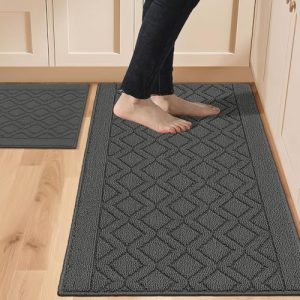Cutting a kitchen worktop might seem tricky, but with the right steps, you can do it yourself and save money. Whether you’re fitting a new kitchen or adjusting an old one, knowing how to cut your worktop accurately is key.
In this guide, you’ll discover simple tips and tools that make the job easier and help you avoid common mistakes. Ready to take control of your kitchen project? Keep reading, and by the end, you’ll feel confident handling your worktop like a pro.
Choosing The Right Worktop Material
Choosing the right worktop material is key for a successful kitchen project. Each material has unique features that affect cutting methods and tools. Understanding these differences helps avoid damage and ensures a clean finish.
Some materials are easier to cut, while others need special equipment. Picking the right one saves time and effort during installation. It also influences the look and durability of your kitchen worktop.
Common Types Of Worktops
- Laminate: Lightweight, budget-friendly, easy to cut with a jigsaw.
- Solid wood: Durable, requires sharp saw blades to avoid splintering.
- Granite: Heavy and hard, needs diamond-tipped blades and professional tools.
- Quartz: Engineered stone, tough but cuts cleanly with a wet saw.
- Marble: Soft stone, delicate cutting to prevent cracking.
- Stainless steel: Requires metal cutting tools and steady hands.
Material-specific Cutting Considerations
- Laminate: Score surface before cutting to reduce chipping.
- Wood: Use fine-toothed blades and clamp worktop firmly.
- Stone (granite, quartz, marble): Always wear safety gear and use water-cooled blades.
- Steel: Cut slowly to avoid warping and sharp edges.
- Measure twice and mark clearly for precise cuts.
- Use appropriate tools for each material to protect the worktop.
Essential Tools For Cutting
Cutting a kitchen worktop requires the right tools to achieve a clean and accurate cut. Using proper tools helps prevent damage to the worktop and ensures safety during the process. Knowing which tools to pick is important before starting.
Power Tools Vs Hand Tools
Power tools make cutting faster and smoother. A circular saw is a popular choice for straight cuts. Jigsaws work well for curved or detailed cuts. Power tools need a steady hand and some experience to avoid mistakes.
Hand tools are slower but give more control. A handsaw or a fine-tooth saw can work well for small cuts. They need less setup and are safer for beginners. Hand tools are good for simple jobs or if power tools are not available.
Safety Gear To Use
Safety gear protects you while cutting. Safety glasses shield your eyes from dust and debris. Ear protection reduces noise from power tools. Gloves protect your hands from sharp edges and splinters.
A dust mask prevents inhaling fine particles. Wear sturdy shoes to protect your feet. Always work in a well-lit and clean space to avoid accidents.
Preparing The Worktop For Cutting
Preparing your kitchen worktop for cutting is a crucial phase that sets the foundation for a clean and precise finish. Taking the time to measure and secure the worktop properly can save you from costly mistakes and frustration. Think about the last time you rushed a DIY project—did it go as smoothly as you hoped? This step demands your full attention to detail.
Measuring And Marking Accurately
Start by measuring the exact length and width needed for your kitchen space. Use a reliable tape measure and double-check your numbers to avoid errors. Mark your cutting line clearly with a pencil or a fine marker; a faint line can lead to uneven cuts.
Consider using a straight edge or a carpenter’s square to keep your markings perfectly straight. It helps if you mark both the top and the side edges to guide your saw precisely. If your worktop has an irregular shape, break the measurements down into smaller sections and mark each carefully.
Securing The Worktop
Before you cut, firmly secure the worktop to a stable surface to prevent any movement. Use clamps to hold it in place—this not only keeps the worktop steady but also protects your hands during cutting. Have you noticed how a wobbly surface can ruin a good cut? Avoid that by ensuring the worktop cannot shift.
If you’re working on sawhorses, make sure they are level and strong enough to support the weight. Place scrap wood underneath if needed to raise the worktop to a comfortable cutting height. This setup reduces strain and improves your control over the saw.
Cutting Techniques For Different Materials
Cutting kitchen worktops demands different techniques for each material type. Each material has its own hardness, texture, and thickness. Using the right cutting method ensures a clean edge and prevents damage. Safety measures are essential to protect yourself and the work surface.
Cutting Laminate Worktops
Laminate worktops are thin and have a plastic surface on particleboard. Use a fine-toothed saw blade for smoother cuts. Mark the cutting line clearly with a pencil.
- Place masking tape over the line to reduce chipping.
- Use a circular saw or jigsaw with a sharp blade.
- Cut slowly to avoid splintering the laminate surface.
- Support the worktop firmly to prevent bending.
Always cut with the finished side facing down. This helps keep the top surface neat.
Cutting Solid Wood Worktops
Solid wood worktops are thicker and denser. Use a circular saw or handsaw with a sharp blade designed for wood.
- Mark your cut line precisely using a straight edge.
- Clamp the worktop to a stable surface to avoid movement.
- Score the cut line lightly before full cutting to guide the saw.
- Cut slowly and steadily to prevent splintering.
Sand the cut edges to smooth rough areas. This protects against splinters.
Cutting Stone And Composite Worktops
Stone and composite worktops are very hard and thick. They require special tools and care.
- Use a diamond-tipped blade on a wet saw for cutting.
- Mark the cutting line with a grease pencil.
- Cut slowly to avoid cracking or chipping the stone.
- Keep the blade and stone wet to reduce dust and heat.
- Wear protective gear like goggles and gloves.
Professional help is often recommended for cutting stone worktops safely.
Handling Edges And Finishing Touches
Handling edges and finishing touches is where your kitchen worktop truly comes to life. After cutting, the raw edges can look rough and unfinished, which affects the overall appearance and durability. Paying close attention here not only improves the look but also protects your worktop from damage and wear over time.
Sanding And Smoothing Edges
Once the cut is made, the edges will almost always be rough or uneven. Use sandpaper starting with a coarser grit, like 80, to remove major imperfections. Then, switch to finer grits—120 and 220—to create a smooth, even surface that feels good to the touch.
Sand in the direction of the grain if your worktop has one, to avoid scratches that stand out. A sanding block or an electric sander can help you maintain even pressure and control. Don’t rush this step; well-sanded edges make a big difference in the final look.
Sealing And Protecting Cut Edges
Cut edges are vulnerable spots that can absorb moisture, stain, or even crack. Applying a sealant or edge protector is essential to keep your worktop durable and looking fresh. For wooden worktops, use a good quality wood sealer or oil designed for kitchen use.
If you’re working with laminate or composite materials, edge banding or waterproof adhesive sealants can prevent water damage. Make sure to apply the sealant evenly and allow it to dry fully before using the surface. Have you ever noticed how sealed edges last so much longer and stay cleaner? That’s no accident—it’s all about this protective step.
Common Mistakes To Avoid
When cutting a kitchen worktop, mistakes can lead to costly errors. Knowing what to avoid ensures a smooth and successful process. Below, we discuss some common mistakes that many make.
Incorrect Measurements
Accurate measurements are crucial for a perfect fit. Many people rush this step. Double-checking your measurements can save you from a poor fit. Always use a reliable measuring tape. Ensure your measurements include all necessary adjustments.
Using The Wrong Tools
Choosing the right tools is essential for a clean cut. Some use inappropriate tools, leading to rough edges. A circular saw with a fine-tooth blade is ideal. Ensure your saw blade is sharp and well-maintained. Proper tools make the job easier and safer.
Rushing The Cutting Process
Rushing often leads to mistakes. Take your time for precise cutting. Steady hands produce smoother edges. Use clamps to secure the worktop firmly. This prevents shifting during cutting. Patience and care result in a professional finish.
Tips For Installing The Cut Worktop
Installing a cut kitchen worktop requires careful attention to detail. Proper fitting and securing ensure a smooth, durable surface. Follow these simple tips to achieve a neat finish and a sturdy installation.
Fitting Around Fixtures
Measure fixtures like sinks and cooktops precisely. Mark the cut lines clearly on the worktop. Use a jigsaw or router for smooth, accurate cuts. Test fit the worktop before securing it. Leave small gaps for expansion and fitting. Seal edges around fixtures to prevent water damage.
Securing The Worktop In Place
Use strong brackets or screws to fix the worktop. Attach supports underneath for extra stability. Check that the worktop is level across the entire surface. Tighten screws carefully to avoid damage. Seal joints with waterproof adhesive or sealant. Allow the sealant to dry fully before use.
Frequently Asked Questions
How Do I Measure A Kitchen Worktop For Cutting?
Measure the worktop length and width accurately with a tape measure. Mark cutting lines clearly using a pencil and a straight edge. Double-check measurements before cutting to avoid mistakes. Proper measuring ensures a perfect fit and smooth installation.
What Tools Are Needed To Cut A Kitchen Worktop?
Essential tools include a circular saw or jigsaw, clamps, a straight edge, and safety gear. Use a fine-tooth blade designed for the worktop material. Proper tools ensure clean, precise cuts and reduce the risk of damaging the worktop.
How Can I Cut A Laminate Kitchen Worktop Smoothly?
Use a circular saw with a fine-tooth blade or a jigsaw. Score the cut line with a utility knife first to reduce chipping. Cut slowly and steadily along the marked line for a smooth finish. Clamping the worktop prevents movement during cutting.
Can I Cut A Granite Worktop At Home?
Cutting granite requires specialized diamond-tipped blades and professional tools. It’s difficult and risky to cut granite at home without experience. Hiring a professional ensures safety and precision. DIY cutting may damage the worktop or cause injury.
Conclusion
Cutting a kitchen worktop takes care and the right tools. Measure twice to avoid mistakes. Use a steady hand and take your time. Clean edges make your worktop look neat and fit well. Safety matters—wear goggles and protect your hands.
Practice on a scrap piece if unsure. Following these steps helps you get a good result. Enjoy your new worktop and the effort you put in. Simple steps, careful work, and patience bring great results.

Sophie Hartwell is the founder of KitchenQuik.com, where she shares kitchen tips, smart cooking hacks, and the best product picks to make everyday cooking easier and more enjoyable.




